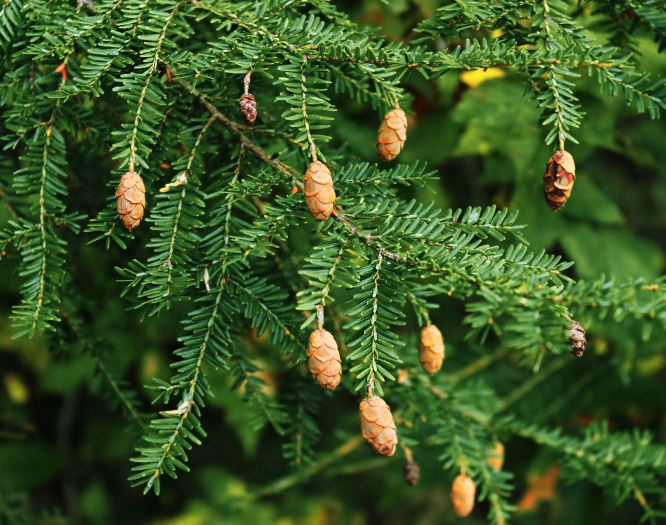Eastern Hemlock
(Tsuga canadensis)
Eastern Hemlock (Tsuga canadensis)
/
/

Nicholas_T
CC0 1.0 Universal
Image By:
Nicholas_T
Recorded By:
Copyright:
CC0 1.0 Universal
Copyright Notice:
Photo by: Nicholas_T | License Type: CC0 1.0 Universal | License URL: https://creativecommons.org/licenses/by/2.0/ | Uploader: Nicholas_T | Publisher: Flickr |













































































Estimated Native Range
Summary
Tsuga canadensis, commonly known as Eastern Hemlock, is an evergreen tree native to cool, moist forests of the Eastern United States and the Maritime Provinces of Canada. It often grows along streams and in swampy areas, thriving in the understory with partial to full shade. Eastern Hemlock can reach heights of about 31 meters (102 feet) with a trunk diameter at breast height often 1.5 meters (4 feet 11 inches). The tree has a straight, monopodial trunk and a broadly conic crown. Its bark is brownish, scaly, and deeply fissured with age. The fine-textured foliage that droops to the ground and the pyramidal growth habit make it a desirable ornamental tree.
Eastern Hemlock is valued for its graceful appearance, ability to withstand hard pruning, and use as a specimen or in group plantings. It is also trained as a dense formal hedge. It prefers slightly acidic to neutral, nutrient-rich, moist but well-drained soils. While it tolerates partial to full shade, it is sensitive to salt spray and not recommended for roadside planting in areas where salt is used in winter. It is also not suited as a windbreak due to winter dieback from wind exposure. Challenges in cultivation include low tolerance of urban stress, intolerance for very wet or very dry soils, and susceptibility to the hemlock woolly adelgid, which is treatable but requires vigilance.CC BY-SA 4.0
Eastern Hemlock is valued for its graceful appearance, ability to withstand hard pruning, and use as a specimen or in group plantings. It is also trained as a dense formal hedge. It prefers slightly acidic to neutral, nutrient-rich, moist but well-drained soils. While it tolerates partial to full shade, it is sensitive to salt spray and not recommended for roadside planting in areas where salt is used in winter. It is also not suited as a windbreak due to winter dieback from wind exposure. Challenges in cultivation include low tolerance of urban stress, intolerance for very wet or very dry soils, and susceptibility to the hemlock woolly adelgid, which is treatable but requires vigilance.CC BY-SA 4.0
Plant Description
- Plant Type: Tree
- Height: 40-75 feet
- Width: 25-35 feet
- Growth Rate: Slow
- Flower Color: N/A
- Flowering Season: Non-Flowering
- Leaf Retention: Evergreen
Growth Requirements
- Sun: Part Shade, Full Shade
- Water: Medium
- Drainage: Fast, Medium
Common Uses
Bank Stabilization, Bird Garden, Border Plant, Deer Resistant, Fragrant, Hedges, Low Maintenance, Rock Garden
Natural Habitat
Cool, moist forests, stream banks, and swampy areas of the Eastern U.S. and the Maritime Provinces
Other Names
Common Names: Black Hemlock, Canada Hemlock, Canadian Hemlock, Common Hemlock, Hemlock Spruce, Hemlock, Eastern Hemlock-Spruce, Jedlovec Kanadský, Tsuga Kanadská, Kanadische Hemlocktanne
Scientific Names: , Tsuga canadensis, Picea glauca f. conica, Pinus pendula, Abies canadensis, Picea canadensis, Tsuga canadensis f. pendula, Picea laxa, Tsuga canadensis f. microphylla, Picea glauca f. parva
GBIF Accepted Name: Tsuga canadensis (L.) Carrière